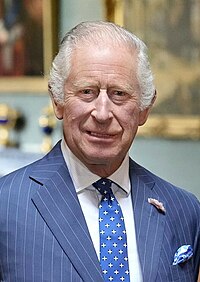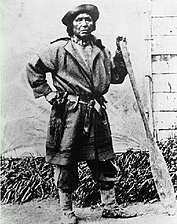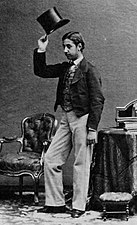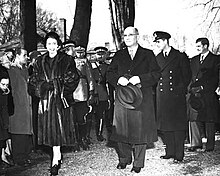
The monarchy of Canada is Canada's form of government embodied by the Canadian sovereign and head of state. It is one of the key components of Canadian sovereignty and sits at the core of Canada's constitutional federal structure and Westminster-style parliamentary democracy. The monarchy is the foundation of the executive (King-in-Council), legislative (King-in-Parliament), and judicial (King-on-the-Bench) branches of both federal and provincial jurisdictions. The current monarch is King Charles III, who has reigned since 8 September 2022.
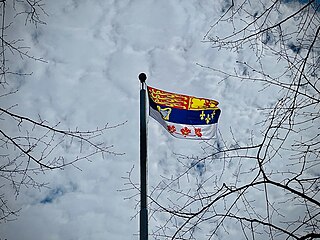
The royal standards of Canada are a set of personal flags used by members of the Canadian royal family to denote the presence of the bearer within any vehicle, building, or area within Canada or when representing Canada abroad. All are based on a banner of the coat of arms of Canada, which are the arms of the Canadian monarch.

The lieutenant governor of Nova Scotia is the representative in Nova Scotia of the Canadian monarch, King Charles III, who operates distinctly within the province but is also shared equally with the ten other jurisdictions of Canada, as well as the other Commonwealth realms and any subdivisions thereof, and resides predominantly in his oldest realm, the United Kingdom. The lieutenant governor of Nova Scotia is appointed in the same manner as the other provincial viceroys in Canada and is similarly tasked with carrying out most of the monarch's constitutional and ceremonial duties. The present, and 33rd lieutenant governor of Nova Scotia is Arthur Joseph LeBlanc, who has served in the role since 28 June 2017.
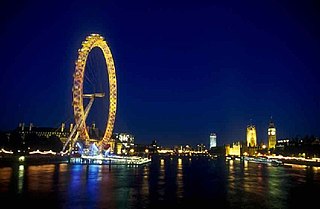
The Golden Jubilee of Elizabeth II was the international celebration held in 2002 marking the 50th anniversary of the accession of Queen Elizabeth II on 6 February 1952. It was intended by the Queen to be both a commemoration of her 50 years as monarch and an opportunity for her to officially and personally thank her people for their loyalty.
The King's Printer is typically a bureau of the national, state, or provincial government responsible for producing official documents issued by the King-in-Council, Ministers of the Crown, or other departments. The position is defined by letters patent under the royal prerogative in various Commonwealth realms.

Canadian royal symbols are the visual and auditory identifiers of the Canadian monarchy, including the viceroys, in the country's federal and provincial jurisdictions. These may specifically distinguish organizations that derive their authority from the Crown, establishments with royal associations, or merely be ways of expressing loyal or patriotic sentiment.

The history of monarchy in Canada stretches from pre-colonial times through to the present day. The date monarchy was established in Canada varies; some sources say it was when the French colony of New France was founded in the name of King Francis I in 1534, while others state it was in 1497, when John Cabot made landfall in what is thought to be modern day Newfoundland or Nova Scotia, making a claim in the name of King Henry VII. Europeans in the 16th and 17th centuries often considered the territories belonging to different aboriginal groups to be kingdoms. Nevertheless, the present Canadian monarchy can trace itself back to the Anglo-Saxon period and ultimately to the kings of the Angles and the early Scottish kings; monarchs reigning over Canada have included those of France, those of the United Kingdom, and those of Canada. Canadian historian Father Jacques Monet said of Canada's Crown, "[it is] one of an approximate half-dozen that have survived through uninterrupted inheritance from beginnings that are older than our Canadian institution itself."

By the arrangements of the Canadian federation, the Canadian monarchy operates in Saskatchewan as the core of the province's Westminster-style parliamentary democracy. As such, the Crown within Saskatchewan's jurisdiction is referred to as the Crown in right of Saskatchewan, His Majesty in right of Saskatchewan, or His Majesty the King in right of Saskatchewan. The Constitution Act, 1867, however, leaves many royal duties in Saskatchewan specifically assigned to the sovereign's viceroy, the Lieutenant Governor of Saskatchewan, whose direct participation in governance is limited by the conventional stipulations of constitutional monarchy.

By the arrangements of the Canadian federation, Canada's monarchy operates in Quebec as the core of the province's Westminster-style parliamentary democracy and constitution. As such, the Crown within Quebec's jurisdiction is referred to as the Crown in Right of Quebec, His Majesty in Right of Quebec, or the King in Right of Quebec. The Constitution Act, 1867, however, leaves many royal duties in the province specifically assigned to the sovereign's viceroy, the lieutenant governor of Quebec, whose direct participation in governance is limited by the conventional stipulations of constitutional monarchy.

By the arrangements of the Canadian federation, the Canadian monarchy operates in Newfoundland and Labrador as the core of the province's Westminster-style parliamentary democracy. As such, the Crown within Newfoundland and Labrador's jurisdiction is referred to as the Crown in Right of Newfoundland and Labrador, His Majesty in Right of Newfoundland and Labrador, or the King in Right of Newfoundland and Labrador. The Constitution Act, 1867, however, leaves many royal duties in the province specifically assigned to the sovereign's viceroy, the lieutenant governor of Newfoundland and Labrador, whose direct participation in governance is limited by the conventional stipulations of constitutional monarchy.

By the arrangements of the Canadian federation, Canada's monarchy operates in British Columbia as the core of the province's Westminster-style parliamentary democracy. As such, the Crown within British Columbia's jurisdiction is referred to as the Crown in Right of British Columbia, His Majesty in Right of British Columbia, or the King in Right of British Columbia. The Constitution Act, 1867, however, leaves many royal duties in British Columbia specifically assigned to the sovereign's viceroy, the Lieutenant Governor of British Columbia, whose direct participation in governance is limited by the conventional stipulations of constitutional monarchy.

By the arrangements of the Canadian federation, the Canadian monarchy operates in Nova Scotia as the core of the province's Westminster-style parliamentary democracy. As such, the Crown within Nova Scotia's jurisdiction is referred to as the Crown in Right of Nova Scotia, His Majesty in Right of Nova Scotia, or the King in Right of Nova Scotia. The Constitution Act, 1867, however, leaves many royal duties in the province specifically assigned to the sovereign's viceroy, the lieutenant governor of Nova Scotia, whose direct participation in governance is limited by the conventional stipulations of constitutional monarchy.

By the arrangements of the Canadian federation, Canada's monarchy operates in Alberta as the core of the province's Westminster-style parliamentary democracy. As such, the Crown within Alberta's jurisdiction is referred to as the Crown in Right of Alberta, His Majesty in Right of Alberta, or The King in Right of Alberta. The Constitution Act, 1867, however, leaves many royal duties in Alberta specifically assigned to the sovereign's viceroy, the Lieutenant Governor of Alberta, whose direct participation in governance is limited by the conventional stipulations of constitutional monarchy.

By the arrangements of the Canadian federation, Canada's monarchy operates in Manitoba as the core of the province's Westminster-style parliamentary democracy. As such, the Crown within Manitoba's jurisdiction is referred to as the Crown in Right of Manitoba, His Majesty in Right of Manitoba, or the King in Right of Manitoba. The Constitution Act, 1867, however, leaves many royal duties in Manitoba specifically assigned to the sovereign's viceroy, the lieutenant governor of Manitoba, whose direct participation in governance is limited by the conventional stipulations of constitutional monarchy.

By the arrangements of the Canadian federation, the Canadian monarchy operates in Prince Edward Island as the core of the province's Westminster-style parliamentary democracy. As such, the Crown within Prince Edward Island's jurisdiction is referred to as the Crown in Right of Prince Edward Island, His Majesty in Right of Prince Edward Island, or the King in Right of Prince Edward Island. The Constitution Act, 1867, however, leaves many royal duties in Prince Edward Island specifically assigned to the sovereign's viceroy, the lieutenant governor of Prince Edward Island, whose direct participation in governance is limited by the conventional stipulations of constitutional monarchy.

The monarchy of Canada forms the core of each Canadian provincial jurisdiction's Westminster-style parliamentary democracy, being the foundation of the executive, legislative, and judicial branches of government in each province. The monarchy has been headed since September 8, 2022 by King Charles III who as sovereign is shared equally with both the Commonwealth realms and the Canadian federal entity. He, his consort, and other members of the Canadian royal family undertake various public and private functions across the country. He is the only member of the royal family with any constitutional role.
In Canada, a number of sites and structures are named for royal individuals, whether a member of the past French royal family, British royal family, or present Canadian royal family thus reflecting the country's status as a constitutional monarchy under the Canadian Crown. Those who married into the royal family are indicated by an asterisk (*). Charles Edward Stuart was a pretender to the British throne.
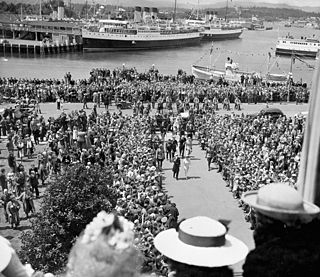
Royal tours of Canada by the Canadian royal family have been taking place since 1786—when the future King William IV became the first member of the royal family to visit Canada—and continue into the 21st century, either as an official tour, a working tour, a vacation, or a period of military service by a member of the royal family. In 1939, King George VI became the first reigning monarch to tour the country.
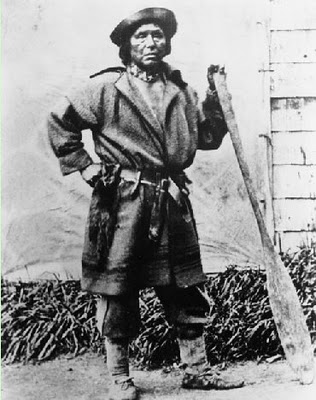
Gabriel Acquin was known by a variety of names; Sachem Gabe and Noel Gabriel being the most verifiable. He was a Maliseet hunter, guide, interpreter and showman who was the founder of the St. Mary's First Nation reserve in Canada.
The 2002 royal tour of Canada by Elizabeth II, Queen of Canada, and her consort Prince Philip, Duke of Edinburgh, took place from 4 to 15 October 2002. The Queen and the Duke toured the Canadian provinces of British Columbia, New Brunswick, Manitoba, Ontario, Quebec, Saskatchewan, and the territory of Nunavut in celebration of her Golden Jubilee as Canada's Queen.

